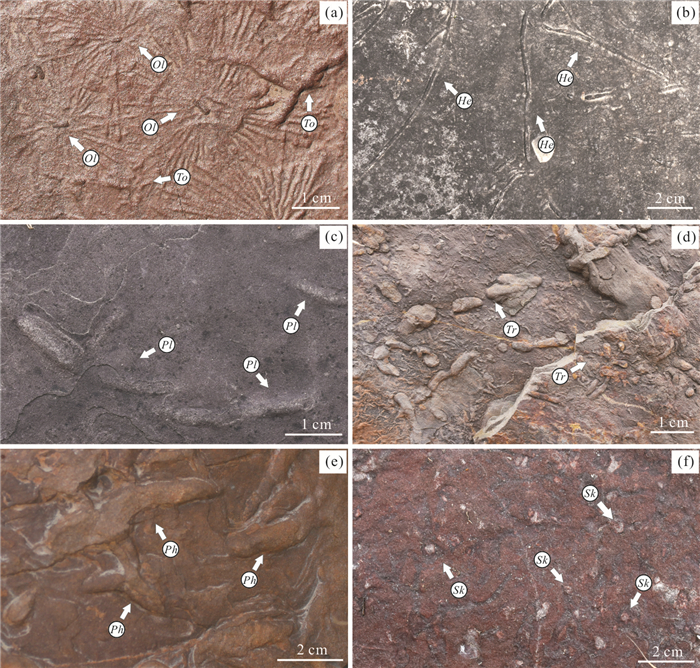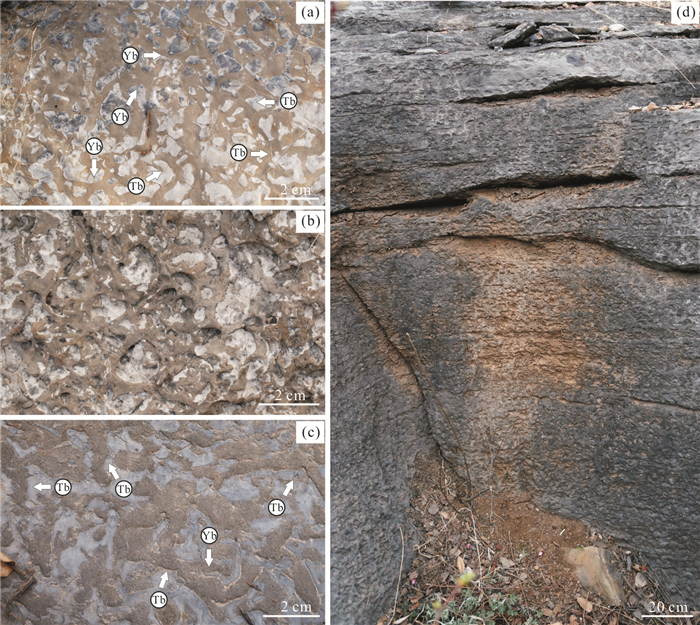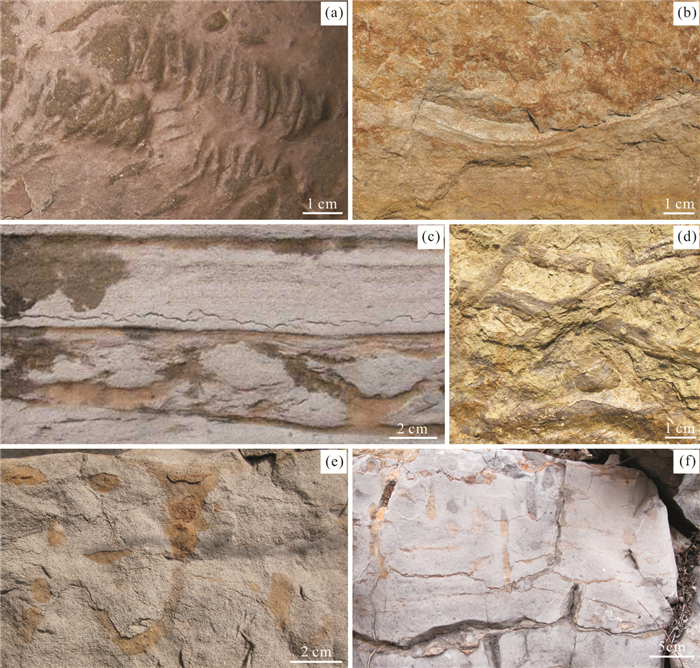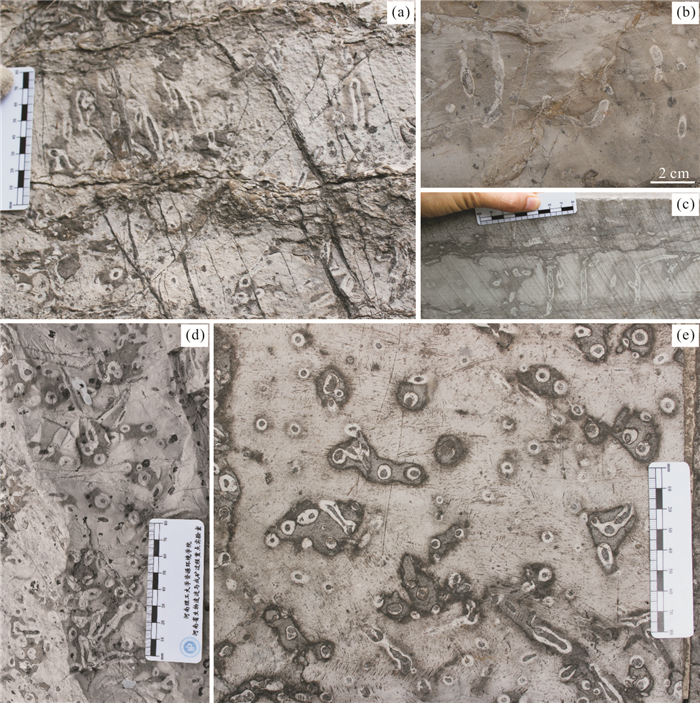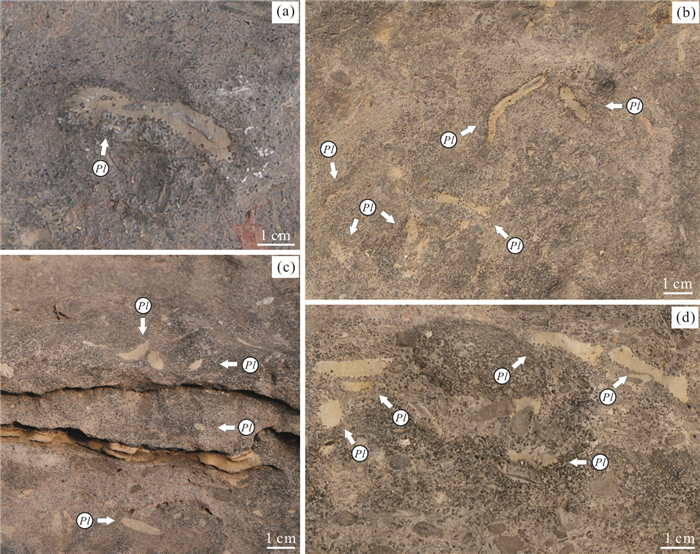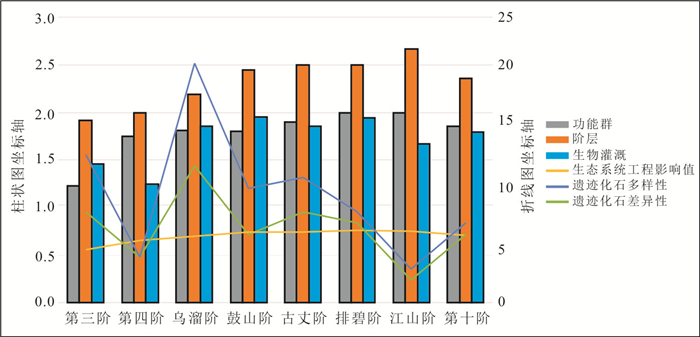Benthic Ecosystem Engineer after the Cambrian Explosion: An Example from Henan Province
-
摘要: 扰动生物作为生态系统工程建造者,通过对沉积底质的改造直接影响沉积物和水体之间的相互作用(营养物质的循环、迁移和存储),对底栖生态系统工程有重要的影响.遗迹化石作为底栖生物活动的载体,为研究寒武纪大爆发之后底栖生态系统工程建造者的演化规律,并评价底栖生态系统工程建造者对生态系统工程产生的影响提供了依据.对河南地区8个寒武系剖面的遗迹化石数据进行统计,应用现代生物学中生态系统工程影响值的概念,从功能群、阶层、生物灌溉3个方面对底栖生态系统工程建造者进行研究.研究结果表明,寒武系第三阶至鼓山阶底栖生态系统工程建造者功能群类型由生物扩散型扰动者往向上/下运输者转变,阶层逐渐加深,生物灌溉越来越普及,生态系统工程影响值不断增大.鼓山阶至第十阶,遗迹化石类型及结构变化不大,生态系统工程影响值趋于稳定.这表明从寒武纪生物大爆发至鼓山阶,底栖生态系统工程建造者的行为策略发生着明显的进化与创新,生态系统工程建造者不仅开拓了重要的生态空间,而且为其他底栖生物和微生物创造了新的生境,在寒武纪海洋生态系统中扮演着重要的角色.Abstract: The bioturbators, which are ecosystem engineers, act on the interaction between sediments and water (the circulation, migration and storage of nutrients) through the reworking of sediments directly. As a result, they have an significant impact on benthic ecosystems engineering. The trace fossils provide evidence for studying the evolution of ecosystem engineers and assessing the impact of engineers on ecosystem engineering after the Cambrian explosion, as they provide records for activities of benthic organism. This paper studies benthic ecosystem engineers from three aspects-functional group, tiering and biological irrigation, by applying the modern biology concept of 'ecosystem engineering impact'. Statistics on the trace fossils of eight Cambrian sections in Henan Province show that the functional group types of the ecosystem engineers have changed from biodiffusive bioturbators to upward/downward conveyors, infaunal tier has gotten deeper, biological irrigation has became more common, and the ecosystem engineering impact has been increasing from Stage 3 to Drumian. But the type and structure of trace fossils have no changes, and the ecosystem engineering impact tends to be stable from Drumian to the Stage 10.This means that the behavioral strategy of benthic ecosystem engineer sevolve and innovate obviously during the time from the ending of the Cambrian Explosion to Drumian, by expanding ecospaces and creating new habitats for other macrobiotic and microbiotic organisms. In a word, these ecosystem engineers played an important role in the Cambrian marine ecosystem.
-
Key words:
- Cambrian /
- benthic organism /
- ecosystem engineer /
- functional groups /
- tiering /
- biological irrigation /
- paleontology
-
图 2 河南寒武系第三阶典型遗迹化石
a. Oldhamia(Ol),由一个中心向外放射的细线组成的放射状花纹,覆盖于层面;Torrowangea(To),蛇曲形潜穴,遗迹表面具有横环节;b. Helminthoidichnites(He),层面蛇曲形光滑通道,互不相交;c. Planolites(Pl),柱形潜穴,水平或略倾斜分布,充填物无结构;d. Treptichnus(Tr),锯齿状潜穴;e. Phycodes(Ph),水平束状的柱形潜穴,表面光滑或具细环纹;f. Skolithos(Sk),垂直潜穴,层面上呈点状
Fig. 2. Typical trace fossils of the Cambrian Stage 3 in Henan Province
图 4 河南寒武系乌溜阶典型潜穴
a. Cruziana,由三叶虫形成的二叶形爬痕; b. Scolicia,平行层面分布,潜穴两侧光滑平整,不发育横向纹饰,遗迹中间的脊条特别明显;c. Arenicolites,垂直层面的宽阔U形潜穴,无蹼状构造,受出露位置影响,其在剖面上往往呈I形或J形;d. Palaeophycus,柱形潜穴微弯曲,不发育分支,表面具纵纹;e. Diplocraterion,潜穴垂向延伸,圆柱形栖管末端呈烟筒状延伸到层面之上,两栖管之间距离3~5 cm; f. Skolithos,垂直或略倾斜管状潜穴,垂向延伸深度5~15 cm
Fig. 4. Typical trace fossils of the Cambrian Wuliuan in Henan Province
表 1 河南寒武系第三阶遗迹化石的生态系统工程影响值
Table 1. The ecosystem engineering impact value of the Cambrian Stage 3 in Henan Province
遗迹化石 (a)功能群α (b)阶层β (c)生物灌溉γ (d)生态系统工程影响值δ Didymaulichnus 1 1 1 3 Gordia 1 1 1 3 Helminthopsis 1 2 1 4 Lumbricarina 1 2 2 5 Oldhamia 1 2 2 5 Palaeophycus 1 2~3 2 5~6 Pelecypodichnus 1 1 1 3 Phycodes 1 3 2 6 Planolites 1 2 1 4 Skolithos 2 2~3 2 6~7 Taenidium 1 2 1 4 Torrowangea 1 2 1 4 Treptichnus 3 3 2 8 注:α: 1.扩散型扰动者; 2.再造者; 3.向上/下运送者; 4.巷道式扩散者; β: 1.表层; 2.半内栖层; 3.浅阶层; 4.中阶层; 5.深阶层;γ: 1.不具有(大部分表栖层运动或觅食迹.不太可能具有生物灌溉); 2.具有(平流主导型); 3.具有(扩散主导型);δ:生态系统工程影响值即a,b,c 3部分最小值和最大值相加所得到的范围. 表 2 河南寒武系第四阶遗迹化石的生态系统工程影响值
Table 2. The ecosystem engineering impact value of the Cambrian Stage 4 in Henan Province
遗迹化石 (a)功能群 (b)阶层 (c)生物灌溉 (d)生态系统工程影响值 Beaconites 1 1 1 3 Oniscoidichnus 1 1 1 3 Planolites 1 2 1 4 Thalassinoides 4 3-5 3 10-12 表 3 河南寒武系乌溜阶遗迹化石的生态系统工程影响值
Table 3. The ecosystem engineering impact value of the Cambrian Wuliuan in Henan Province
遗迹化石 (a)功能群 (b)阶层 (c)生物灌溉 (d)生态系统工程影响值 Arenicolites 3 3 2 8 Beaconites 1 1 1 3 Bergaueria 2 2 1 5 Bifungites 2 2 1 5 Cruziana 1 1 1 3 Didymaulichnus 1 1 1 3 Dimorphichnus 1 1 1 3 Diplichnites 1 1 1 3 Diplocraterion 3 4 3 10 Gordia 1 1 1 3 Monocraterion 3 3 3 9 Monomorphichnus 1 1 1 3 Palaeophycus 1 3 3 7 Phycodes 1 3 2 6 Planolites 1 2 1 4 Qipanshanichnus 1 1 1 3 Rusophycus 1 1 1 3 Scolicia 1 1~2 1 3~4 Skolithos 2 3~5 2~3 7~10 Thalassinoides 4 3 3 10 Treptichnus 3 3 2 8 表 4 河南寒武系鼓山阶至第十阶遗迹化石的生态系统工程影响值
Table 4. The ecosystem engineering impact value of the Cambrian Drumian to Stage 10 trace fossils in Henan Province
遗迹化石 (a)功能群 (b)阶层 (c)生物灌溉 (d)生态系统工程影响值 Arenicolites 3 3 2~3 8~9 Bergaueria 2 3 3 8 Cruziana 1 1 1 3 Diplichnites 1 1 1 3 Palaeophycus 1 3 3 7 Helminthopsis 1 2 1 4 Planolites 1 2~5 1~2 4~8 Skolithos 2 3~5 2~3 7~10 Treptichnus 3 3 2 8 Thalassinoides 3~4 3~4 3 9~11 -
Aller, R. C., 1982. The Effects of Macro Benthos on Chemical Properties of Marine Sediment and Overlying Water. In: McCall, P. L., Tevesz, M. J. S., eds., Animal-Sediment Relations. Journal of Geobiology, New York, 53-102. Allison, P. A., Wright, V. P., 2005. Switching off the Carbonate Factory: A-Tidality, Stratification and Brackish Wedges in Epeiric Seas. Sedimentary Geology, 179(3/4): 175-184. https://doi.org/10.1016/j.sedgeo.2005.05.004 Ausich, W. I., Bottjer, D. J., 1982. Tiering in Suspension-Feeding Communities on Soft Substrata Throughout the Phanerozoic. Science, 216(4542): 173-174. https://doi.org/10.1126/science.216.4542.173 Bai, W.B., Qi, Y.A., Guo, Y.H., et al., 2018. Storm Deposits and Relevant Trace Fossils from the Cambrian Series 2 Xinji Formation in Lushan Area, Henan Province. Journal of Palaeogeography, 20(3): 365-376(in Chinese with English abstract). http://en.cnki.com.cn/Article_en/CJFDTotal-GDLX201803002.htm Bottjer, D. J., Ausich, W. I., 1986. Phanerozoic Development of Tiering in Soft Substrata Suspension-Feeding Communities. Paleobiology, 12(4): 400-420. https://doi.org/10.1017/s0094837300003134 Buatois, L. A., Mángano, M. G., 2012. An Early Cambrian Shallow-Marine Ichnofauna from the Puncoviscana Formation of Northwest Argentina: The Interplay between Sophisticated Feeding Behaviors, Matgrounds and Sea-Level Changes. Journal of Paleontology, 86(1): 7-18. https://doi.org/10.1666/11-001.1 Buatois, L. A., Narbonne, G. M., Mángano, M. G., et al., 2014. Ediacaran Matground Ecology Persisted into the Earliest Cambrian. Nature Communications, 5(1): 35-44. https://doi.org/10.1038/ncomms4544 Bush, A. M., Bambach, R. K., Daley, G. M., 2007. Changes in Theoretical Ecospace Utilization in Marine Fossil Assemblages between the Mid-Paleozoic and Late Cenozoic. Paleobiology, 33(1): 76-97. https://doi.org/10.1666/06013.1 Chen, X., Ling, H. F., Vance, D., et al., 2015. Rise to Modern Levels of Ocean Oxygenation Coincided with the Cambrian Radiation of Animals. Nature Communications, 6(1): 8142. https://doi.org/10.1038/ncomms8142 Chen, Z., Chen, X., Zhou, C. M., et al., 2018. Late Ediacaran Trackways Produced by Bilaterian Animals with Paired Appendages. Science Advances, 4(6): 6691. https://doi.org/10.1126/sciadv.aao6691 Collette, J. H., Hagadorn, J. W., 2010. Early Evolution of Phyllocarid Arthropods: Phylogeny and Systematics of Cambrian-Devonian Archaeostracans. Journal of Paleontology, 84(5): 795-820. https://doi.org/10.1666/09-092.1 Dornbos, S. Q., 2006. Evolutionary Palaeoecology of Early Epifaunal Echinoderms: Response to Increasing Bioturbation Levels during the Cambrian Radiation. Palaeogeography, Palaeoclimatology, Palaeoecology, 237(2/3/4): 225-239. https://doi.org/10.1016/j.palaeo.2005.11.021 Fang, L., Liu, J.B., Zhan, R.B., 2012. Temporal Distribution of Piperocks in Cambrian and Ordovician: A Coevolutionary Process with Changes of Paleoenvironment. Scientia Sinica Terrae, 42(1): 117-129 (in Chinese with English abstract). doi: 10.1360/zd-2012-42-1-117 François, F., Gerino, M., Stora, G., et al., 2002. Functional Approach to Sediment Reworking by Gallery-Forming Macrobenthic Organisms: Modeling and Application with the Polychaete Nereis Diversicolor. Marine Ecology Progress Series, 229: 127-136. https://doi.org/10.3354/meps229127 Herringshaw, L. G., Callow, R. H. T., McIlroy, D., 2017. Engineering the Cambrian Explosion: The Earliest Bioturbators as Ecosystem Engineers. Geological Society, London, Special Publications, 448(1): 369-382. https://doi.org/10.1144/sp448.18 Herringshaw, L. G., McIlroy, D., 2013. Bioinfiltration: Irrigation-Driven Transport of Clay Particles through Bioturbated Sediments. Journal of Sedimentary Research, 83(6): 443-450. https://doi.org/10.2110/jsr.2013.40 Kristensen, E., Kostka, J. E., 2005. Macro Faunal Burrows and Irrigation in Marine Sediment: Microbiological and Biogeochemical Interactions. In: Kristensen, E., Haese, R., Kostka, J. E., eds., Interactions Between Macro- and Micro-Organisms in Marine Sediments. Coastal and Estuarine Studies, Washington, 125-157. Li, D., Qi, Y., Dai, M.Y., et al., 2016. Firm-ground Trace Fossils in the Mantou Formation(Cambrian Series 2 and 3), Western Henan, Central China. Acta Palaeontologica Sinica, 55(2): 170-180 (in Chinese with English abstract). http://en.cnki.com.cn/Article_en/CJFDTOTAL-GSWX201602004.htm Mángano, M. G., Buatois, L. A., 2014. Decoupling of Body-Plan Diversification and Ecological Structuring during the Ediacaran-Cambrian Transition: Evolutionary and Geobiological Feedbacks. Proceedings of the Royal Society B: Biological Sciences, 281(1780): 20140038. https://doi.org/10.1098/rspb.2014.0038 McIlroy, D., Garton, M., 2010. Realistic Interpretation of Ichnofabrics and Palaeoecology of the Pipe-Rock Biotope. Lethaia, 43(3):420-426. https://doi.org/10.1111/j.1502-3931.2009.00199.x Mermillod-Blondin, F., Rosenberg, R., 2006. Ecosystem Engineering: The Impact of Bioturbation on Biogeochemical Processes in Marine and Freshwater Benthic Habitats. Aquatic Sciences, 68(4): 434-442. https://doi.org/10.1007/s00027-006-0858-x Meyer, M., Xiao, S. H., Gill, B. C., et al., 2014. Interactions between Ediacaran Animals and Microbial Mats: Insights from Lamonte Trevallis, a New Trace Fossil from the Dengying Formation of South China. Palaeogeography, Palaeoclimatology, Palaeoecology, 396: 62-74. https://doi.org/10.1016/j.palaeo.2013.12.026 Minter, N. J., Buatois, L. A., Mángano, M. G., 2016.The Conceptual and Methodological Tools of Ichnology. In: Mángano, M. G., Buatois L A., eds., The Trace-Fossil Record of Major Evolutionary Events. Dordrecht: Springer Science, Business Media, 1-26. Muscente, A. D., Boag, T. H., Bykova, N., et al., 2018. Environmental Disturbance, Resource Availability, and Biologic Turnover at the Dawn of Animal Life. Earth-Science Reviews, 177: 248-264. https://doi.org/10.1016/j.earscirev.2017.11.019 Qi, Y.A., Wang, M., Li, D., et al., 2012a. Cambrian Substrate Revolution: From Matgrounds to Bioturbated Mixgrounds. Journal of Henan Polytechnic University, , 31(2): 159-164 (in Chinese with English abstract). http://en.cnki.com.cn/Article_en/CJFDTOTAL-JGXB201202009.htm Qi, Y.A., Meng, Y., Dai, M.Y., et al., 2014. Biogenic Leopard Patch Structures from the Zhushadong Formation (Cambrian Series 2), Dengfeng Area, Western Henan. Geological Science and Technology Information, 33(5): 1-8 (in Chinese with English abstract). http://en.cnki.com.cn/Article_en/CJFDTotal-DZKQ201405001.htm Qi, Y.A., Li, D., Dai, M.Y., et al., 2013. Opportunistic Trace Fossils from the Changhia Formation (Third Series, Cambrian), Western Henan. Acta Palaeontologica Sinica, 52(1): 80-85 (in Chinese with English abstract). http://en.cnki.com.cn/Article_en/CJFDTotal-GSWX201301008.htm Qi, Y.A., Wang, M., Li, D., et al., 2012b. Ichnofabrics and Their Sedimentary Environments from the Lower Part of the Middle Cambrian Zhangxia Formation, Longmen Area, Luoyang City. Earth Science, 37(4): 693-706 (in Chinese with English abstract). http://en.cnki.com.cn/Article_en/CJFDTOTAL-DQKX201204009.htm Seilacher, A., 1999. Biomat-Related Lifestyles in the Precambrian. Palaios, 14(1):86. https://doi.org/10.2307/3515363 Tarhan, L. G., Droser, M. L., Planavsky, N. J., et al., 2015. Protracted Development of Bioturbation through the Early Palaeozoic Era. Nature Geoscience, 8(11): 865-869. https://doi.org/10.1038/ngeo2537 Tyson, R. V., Pearson, T. H., 1991. Modern and Ancient Continental Shelf Anoxia: An Overview. Geological Society, London, Special Publications, 58(1): 1-24. https://doi.org/10.1144/gsl.sp.1991.058.01.01 Vannier, J., Calandra, I., Gaillard, C., et al., 2010. Priapulid Worms: Pioneer Horizontal Burrowers at the Precambrian-Cambrian Boundary. Geology, 38(8): 711-714. https://doi.org/10.1130/g30829.1 Vannier, J., Steiner, M., Renvoisé, E., et al., 2007. Early Cambrian Origin of Modern Food Webs: Evidence from Predator Arrow Worms. Proceedings of the Royal Society B: Biological Sciences, 274(1610): 627-633. https://doi.org/10.1098/rspb.2006.3761 Williams, M., Vandenbroucke, T. R. A., Perrier, V., et al., 2015. A Link in the Chain of the Cambrian Zooplankton: Bradoriid Arthropods Invade the Water Column. Geological Magazine, 152(5): 923-934. https://doi.org/10.1017/s0016756815000059 Yang, S.P., Chen, Z.J, 1996. Middle Cambrian Hsvchuangian Trace Fossils from Dengfeng, Henan Province, and Their Environmental Significance. Regional Geology of China, (2): 143-149, T002 (in Chinese with English abstract). http://en.cnki.com.cn/Article_en/CJFDTOTAL-ZQYD602.006.htm Yang, W.T., Li, K.N., Wang, M., et al., 2017. Schaubcylindrichnus Heberti from the Zhangxia Formation (Cambrian Series 3) in Henan Province and Its Ethological Characteristics. Acta Palaeontologica Sinica, 56(3): 312-321 (in Chinese with English abstract). http://en.cnki.com.cn/Article_en/CJFDTOTAL-GSWX201703005.htm Zamora, S., Deline, B., Javier Álvaro, J., et al., 2017. The Cambrian Substrate Revolution and the Early Evolution of Attachment in Suspension-Feeding Echinoderms. Earth-Science Reviews, 171: 478-491. https://doi.org/10.1016/j.earscirev.2017.06.018 Zhang, L. J., Qi, Y. A., Buatois, L. A., et al., 2017. The Impact of Deep-Tier Burrow Systems in Sediment Mixing and Ecosystem Engineering in Early Cambrian Carbonate Settings. Scientific Reports, 7(1): 45773. https://doi.org/10.1038/srep45773 Zhao, X.K., Shi, X.Y., Wang, X.Q., et al., 2018. Stepwise Oxygenation of Early Cambrian Ocean Drove Early Metazoan Diversification. Earth Science, 43(11): 3873-3890 (in Chinese with English abstract). http://en.cnki.com.cn/Article_en/CJFDTotal-DQKX201811006.htm 白万备, 齐永安, 郭英海, 等, 2018.河南鲁山寒武系第二统辛集组风暴沉积及其相关的遗迹化石.古地理学报, 20(3): 365-376. https://www.cnki.com.cn/Article/CJFDTOTAL-GDLX201803002.htm 房亮, 刘建波, 詹仁斌, 2012.寒武纪-奥陶纪管状岩的盛衰及其与环境演变的协同.中国科学(地球科学), 42(1): 117-129. https://www.cnki.com.cn/Article/CJFDTOTAL-JDXK201201014.htm 李妲, 齐永安, 代明月, 等, 2016.豫西寒武系第二、三统馒头组固底控制的遗迹化石.古生物学报, 55(2): 170-180. https://www.cnki.com.cn/Article/CJFDTOTAL-GSWX201602004.htm 齐永安, 李妲, 代明月, 等, 2013.豫西寒武系第三统张夏组鲕粒灰岩中机会生物留下的遗迹化石.古生物学报, 52(1): 80-85. https://www.cnki.com.cn/Article/CJFDTOTAL-GSWX201301008.htm 齐永安, 孟瑶, 代明月, 等, 2014.豫西登封地区寒武系第二统朱砂洞组生物成因的豹斑构造.地质科技情报, 33(5): 1-8. https://www.cnki.com.cn/Article/CJFDTOTAL-DZKQ201405001.htm 齐永安, 王敏, 李妲, 等, 2012a.寒武纪底质革命:从微生物席底到生物扰动混合底.河南理工大学学报(自然科学版), 31(2): 159-164. https://www.cnki.com.cn/Article/CJFDTOTAL-JGXB201202009.htm 齐永安, 王敏, 李妲, 等, 2012b.洛阳龙门地区中寒武统张夏组下部遗迹组构及其沉积环境.地球科学, 37(4): 693-706. http://www.earth-science.net/article/id/2275 杨式溥, 陈战杰, 1996.河南登封中寒武世徐庄组遗迹化石及其沉积环境.中国区域地质, (2): 143-149, T002. https://www.cnki.com.cn/Article/CJFDTOTAL-ZQYD602.006.htm 杨文涛, 李凯楠, 王敏, 等, 2017.豫西寒武系第三统张夏组Schaubc ylindrichnus heberti及其生态学特征.古生物学报, 56(3): 312-321. https://www.cnki.com.cn/Article/CJFDTOTAL-GSWX201703005.htm 赵相宽, 史晓颖, 王新强, 等, 2018.寒武纪早期海洋阶段性氧化驱动早期后生动物多样化进程.地球科学, 43(11):3873-3890. doi: 10.3799/dqkx.2018.143 -









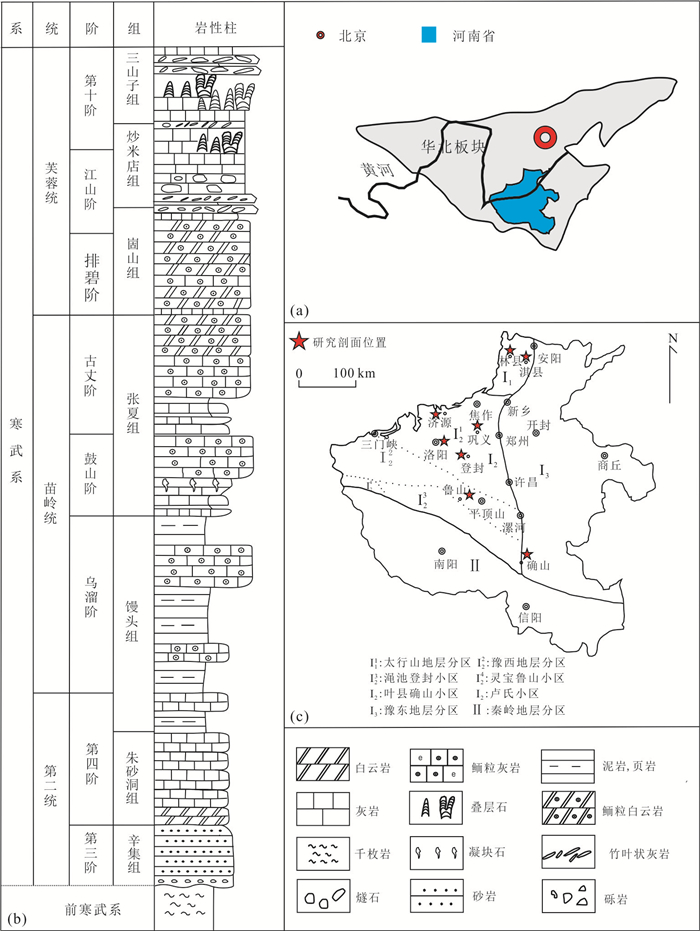
 下载:
下载:
